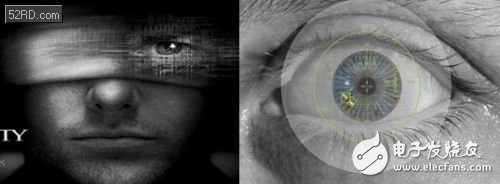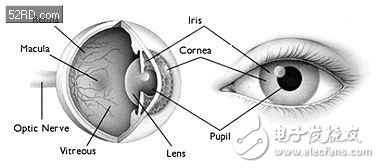At the World Mobile Conference held in Barcelona in March this year, Fujitsu released a mobile phone with iris recognition function, which can scan the user's eye features and use it to unlock functions such as the screen. The technology is very avant-garde.

Today, we will introduce this more secure identification system - iris recognition technology.
Iris recognition, secure biometrics
The structure of the human eye consists of the sclera, iris, pupillary lens, retina and the like. The iris is an annular part between the black pupil and the white sclera, which accounts for about 65% of the total area of ​​the eye. Appearance, the iris is a fabric-like ring of color in the pupil of the eye, each iris contains a unique image based on crowns, crystals, filaments, spots, pits, rays, wrinkles and stripes. The structure of the feature.

The uniqueness, stability and unchangeable nature of the iris are the basis for identity recognition.
The iris has the following characteristics:
1. Uniqueness: Physiological studies have shown that the detailed characteristics of iris texture are determined by random factors in the embryonic development environment. The random distribution of this texture detail lays a physiological foundation for the uniqueness of the iris. Studies have shown that even if there are significant differences between the twin images of the twins and the eyes of the same person, it is impossible for the two irises to be identical in nature.
2. Stability: The iris develops from the third month before the embryonic stage of the baby, and the main texture of the iris has been formed by the eighth month. At the same time, due to the protective effect of the cornea, the fully developed iris is not vulnerable to external damage. Therefore, the probability of an iris change caused by external physical contact is very small. Scientists have found that the iris texture is almost unchanged throughout the surgery, which is endangered by the eye.
3. Good anti-counterfeiting: the acquisition of clear iris texture requires special iris image acquisition device and user cooperation, so it is difficult to steal other people's iris images under normal circumstances (relative to fingerprints and faces). In addition, the eye also has many excellent optical and physiological properties for in vivo iris detection.
4. Non-contact: The iris is an externally visible internal organ that is more hygienic and convenient than the biological features that need to be contacted and collected. This is very different from external organs such as fingerprints and faces: a non-contact (even long-distance) acquisition device can obtain a qualified iris image. This is very important in practical applications.

Iris recognition is a biometric technology developed based on the characteristics of the iris. In 1885, Alphonse BerTIllon used the idea of ​​biometric identification to apply to the criminal prison in Paris. The biometrics used at that time included: the size of the ears, the feet. Length, iris, etc. In 1987, ophthalmologists Aran Safir and Leonard Flom first proposed the concept of automatic iris recognition using iris images. By 1991, Johnson of the Los Alamos National Laboratory in the United States realized an automatic iris recognition system.
Iris recognition process
It can be easily divided into iris image acquisition, image preprocessing, feature extraction and coding, feature matching and recognition. Since the iris can exhibit good texture under infrared conditions, the camera required for shooting needs to be able to have infrared shooting conditions.
1. Iris image acquisition
The acquisition of iris images is the first step in iris recognition. The diameter of the iris is about ten millimeters. The color of the iris of different races is very different. The iris of the yellow race is mostly dark brown, and the texture is not obvious. A special iris image acquisition device must be used to capture the iris image with rich texture.
2. Pretreatment of iris images
There are mainly iris localization, iris normalization and iris image enhancement.
â—Iris positioning: It is the most important part of the whole iris recognition process. Iris positioning is to accurately determine the inner and outer boundaries of the iris, ensuring that there is no large deviation in the iris area for each feature extraction, and the speed and accuracy of positioning. It determines whether the entire iris system is practical and feasible.
â—Iris normalization: For comparison purposes, the iris recognition system generally normalizes the iris, the purpose of which is to adjust each original image to the same size and corresponding position, thus eliminating the translation, scaling and rotation pairs. The effect of iris recognition.
• Iris image enhancement: If the acquired image for iris recognition is not clear, it will greatly affect the recognition performance of the iris recognition system, and the iris image is usually improved by the reconstruction-based super-resolution method.
3. Iris feature extraction and coding
The corresponding algorithm is used to extract the unique details of the iris image, and the appropriate feature recording method is adopted to form the iris code, and finally the feature template or the model model is formed. The result of this link is directly related to the accuracy of the iris recognition. .
4. Matching and identification
Iris recognition is a typical pattern matching problem. The characteristics of the acquired image are compared with the iris image feature template in the database to determine whether the two irises belong to the same class. The matching process of the iris recognition system can be divided into two forms of identification and authentication.
Identification is to compare the feature to be identified with all stored feature templates, and to find the pattern to be identified from multiple classes is a one-to-many comparison problem.
The authentication compares the feature to be identified with the identity template declared by the user, and judges whether it belongs to the same mode according to the comparison result, and completes one-to-one comparison. Authentication is much smaller and faster than recognition.
Iris recognition module, a mature solution
A complete iris recognition system, in addition to the algorithm, there is an iris recognition acquisition device---Iris recognition module. Haoyu Optoelectronics has developed a number of solutions, all of which can be applied to mobile phones.

Iris recognition is widely used, mobile phones with iris recognition, just around the corner
Iris recognition is widely used in mobile payment and identity authentication because of its uniqueness, stability, possession of a large amount of information, and no contact when it is recognized. Compared with traditional payment methods, mobile payment based on iris recognition has fully utilized its technical advantages. Combining iris recognition technology with mobile devices will miniaturize the iris recognition device, thus further expanding its application area. Users only need to have a mobile device with red film recognition function. After registering their iris information and uploading it to the cloud, banks, social security, medical care, education and other related departments will establish a database of their personal identity, which can solve in mobile commerce and Unpredictable security and personal authentication issues in daily payments, while providing more efficient and accurate identity authentication for a wider range of mobile commerce.
With the rapid popularization of intelligent terminals, the mature communication network technology, the rapid development of mobile Internet economy, and the increasing transaction amount of mobile payment single business, the security of mobile payment system is one of the core problems and main bottlenecks restricting the development of mobile payment. Operation must rely on computer network technology; however, the freedom and openness of the mobile Internet inevitably exposes payment behavior to various security risks and threats. Iris recognition technology, due to its unique advantages in acquisition, accuracy, etc., will inevitably become the mainstream biometric authentication technology in the future society. The combination with smartphones will play a huge role in personal mobile secure payment, and its application trend has gradually begun to emerge.
Xinxiang Mina Import & Export Co., Ltd. , https://www.mina-motor.cn